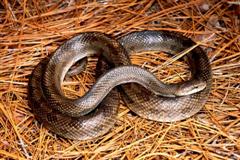Kingsnake - Prairie
Scientific Name: Lampropeltis calligaster calligaster
Thu, 17th April, 2025 - 7:57 am GMT
Sponsor Ads:

Alternative Name
Scientific Name: Lampropeltis calligaster calligasterBasic Info
The moderately sized Prairie Kingsnake averages between 30 and 42 inches in length. They vary greatly in color, appearing in both light and dark varieties depending on where they are from. Generally speaking, their light brown or gray body is marked with darker brown, olive, or reddish blotches. As the snake matures, the blotches often fade and four long stripes take their place. The underside of the Prairie Kingsnake is light colored usually a yellow or cream color with brown checks. They often have a line of a dark color extending from the eye to the jaw. The scales on the Prairie Kingsnake are smooth, making it a delight to handle. The Prairie Kingsnake can be bred in albino or striped varieties.
Health
Breeding To breed Prairie Kingsnakes in captivity, they must first undergo a period of brumation. The temperature within their enclosure should be decreased to the mid 50s or low 60s (Fahrenheit) and feeding should be stopped. During this time, water should always be available. After a couple of months, the temperature should be increased to its normal 78 to 82 degrees Fahrenheit and they should be fed regularly again. After about three weeks, the snakes will be ready to mate. After the eggs are laid, they should be kept at temperatures between 80 and 83 degrees until they hatch. They usually hatch between 58 and 66 days after being laid.Habitat
Found primarily in the Midwest, the Prairie Kingsnake is quite common in Iowa.Behavior
The Prairie Kingsnake is an active, yet secretive snake that can be found in the Midwestern United States. They are quite docile and easy to care for, which makes them good pets for beginners. As it moves through the prairies, fields, ditches, pastures, grasslands, and woodlands that they make their home, the Prairie Kingsnake feeds on lizards, birds, snakes, eggs, frogs, lizards and small mammals. They often choose to hunt near people's houses or barns, which is beneficial to both the human and the snake: the snake gets plenty of food, and the human doesn't have to worry so much about rodents and poisonous snakes. As a kingsnake, the Prairie Kingsnake will kill and eat venomous snakes. The venom of snakes in North America cannot harm them. The Prairie Kingsnake is primarily diurnal. It is active during the day in the spring and fall, although they often switch their habits to a nocturnal lifestyle in the hot summer months. They usually hibernate from October to April in the wild. While the Prairie Kingsnake can be an aggressive feeder and often makes a meal of other snakes, even those of the same species, they are generally very docile and easy to handle despite their secretive nature.Origin
North AmericaHistory
N/ACommon Foods
feeds on lizards, birds, snakes, eggs, frogs, lizards and small mammalsSponsor Ads:
I am concerned about any program, any piece of hardware, any treaty, any law that treats me as a consumer, not a citizen -- dowobeha on Slashdot
Kingsnake - Prairie
Coded by: BGID® | ALL RIGHTS RESERVED Copyright © 2000-2025
Disclaimer | Privacy | Report Errors / Contact | Credits








 Preparing For China. China is growing their military. China Military Technology - can it keep up with the US?
Preparing For China. China is growing their military. China Military Technology - can it keep up with the US?  versus
versus 

 versus
versus 
 This Thread is about the North Korean Military itself - the kind of army, navy, and air force they have.
This Thread is about the North Korean Military itself - the kind of army, navy, and air force they have. 
 versus
versus 
 versus
versus  versus
versus